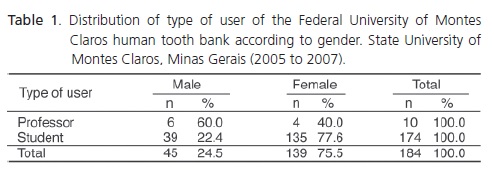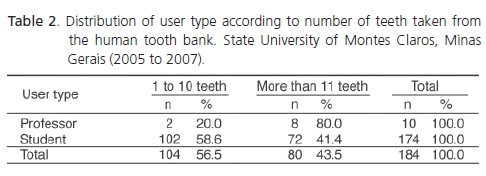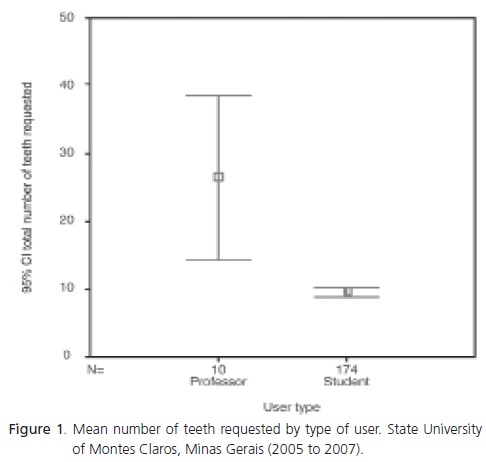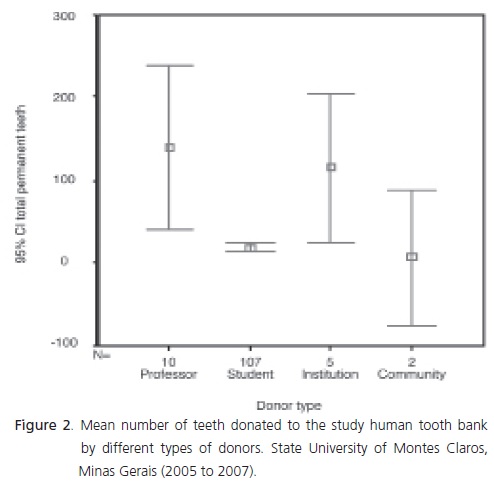Serviços Personalizados
Artigo
Links relacionados
Compartilhar
RGO.Revista Gaúcha de Odontologia (Online)
versão On-line ISSN 1981-8637
RGO, Rev. gaúch. odontol. (Online) vol.60 no.2 Porto Alegre Abr./Jun. 2012
ORIGINAL / ORIGINAL
Assessment of a state university tooth bank two years after its foundation
Funcionalidade do Banco de Dentes de uma Universidade Estadual durante os dois anos de implantação
Simone de Melo COSTA I; Eduardo Brandão LIMA I; Flávia Milene de ABREU I; Soraya MAMELUQUE I; Paulo Rogério Ferreti BONAN I
I Universidade Estadual de Montes Claros, Departamento de Odontologia. Av. Cula Mangabeira, 562, Santo Expedito, 39401-001, Montes Claros, MG, Brasil
ABSTRACT
Objective
This study assessed the State University of Montes Claros human tooth bank two years after its foundation.
Methods
The 2005 and 2007 tooth bank records and inventory were analyzed. Two examiners underwent intra- and inter-calibration training (Kappa=1) before inventory assessment. The data were processed by the software SPSS considering measures of central tendency and dispersion, and submitted to the Student's t-test, Chi-square test, ANOVA and Bonferroni correction (p<0.05).
Results
Most (75.5%) tooth bank users are females. Each user requests a mean of 10.46±7.26 teeth, where 26.40 teeth are requested by professors and 9.55 teeth are requested by students (p<0.05). The teeth were requested for preclinical use (94.2%), research (4.7%) and biological restorations (1.0%). Most donors (80.5%) are students but the mean number of teeth donated by professors (140±206.16) and students (18.04±26.10) and by males and females differed significantly (p<0.05). In 2007, the tooth bank had a total of 4.593 teeth.
Conclusion
Donors include students, professors, community and the institution, and most donors are female. The tooth bank contributed to an ethical, legal and biologically safe supply of human teeth.
Indexing terms: Bioethics. Dentistry. Teaching.
RESUMO
Objetivo
Avaliar a funcionalidade do Banco de Dentes Humanos da Universidade Estadual de Montes Claros durante os dois anos de implantação.
Métodos
Para esse fim, analisaram-se dados arquivados de junho/2005 a julho/2007, e o estoque de dentes de 2007. Dois examinadores avaliaram o estoque de dentes após calibração intra e inter examinadores (Kappa=1). Analisaram-se os dados no software SPSS, considerando medidas de tendência central e dispersão, e os testes t (student), Qui-quadrado, Anova e Bonferroni (p<0,05) foram feitos.
Resultados
A maioria (75,5%) dos solicitantes de dentes é do sexo feminino. A média de dentes solicitados por indivíduo foi 10,46 (±7,26), sendo 26,40 para professores e 9,55 para alunos (p<0,05). Os fins de uso foram pré-clínicos (94,2%), pesquisa (4,7%) e restauração biológica (1,0%). A maioria (80,5%) dos doadores são estudantes, no entanto, houve diferença entre as médias de dentes doados pelos professores (140±206,16) e acadêmicos (18,04±26,10), e entre sexos (p<0,05). O estoque em 2007 foi de 4.593 dentes.
Conclusão
As doações são procedentes de alunos, professores, comunidade no geral e instituição, com participação majoritária do sexo feminino. A utilização dos dentes é para fins de ensino, pesquisa e atividades clínicas. O estoque de dentes contribuiu para a disposição do mesmo de forma ética, legal e respeitando a biossegurança.
Termos de indexação: Bioética. Odontologia. Ensino.
INTRODUCTION
The establishment of a human tooth bank (HTB) in all dental schools is essential for teaching students the ethical uses of human teeth1. University HTB can supply teeth for teaching activities, research and therapeutic purposes. The availability of human teeth is extremely important for the teaching process, contributing to the education of future dental surgeons. The use of human teeth helps the student recognize their anatomical structures, practice cavity preparations and instrument root canals before treating patients at the dental clinic.
The State University of Montes Claros human tooth bank (Unimontes-HTB) was founded in May 2005, after approval from the Teaching, Research and Extension Council (CEPEX) in 2004. It is open daily and its objectives are to educate students, professors and researchers about the importance of teeth as accessory organs; supply teeth for preclinical and clinical academic activities; contribute to the advancement of science; and ensure safe handling, according to National Sanitary Surveillance Agency biosafety guidelines. Hence, the Unimontes-HTB accepts tooth donations and loans or grants them to researchers, students and professors in an ethical, legal and biologically safe manner2-3.
Unimontes-HTB objectives are in agreement with those of other tooth banks reported in the literature, which are to prioritize some roles for good HTB functioning: appreciation of teeth as accessory organs; tooth collection; tooth preparation; tooth loaning and/or granting; administration of data and records; and performance of research and teaching activities2.
This study assessed Unimontes-HTB activities from June 2005, when it was founded, to July 2007, by examining its documents and inventory records.
METHODS
A non-experimental, retrospective, descriptive study was done to analyze secondary UNIMONTES-HTB data from 2005 to 2007 and a cross-sectional study was done to verify its inventory in 2007. The retrospective study included analysis of tooth loaning or granting forms and the records of teeth donated to Unimontes-HTC. The crosssectional study counted the groups of teeth in Unimontes- HTB inventory.
Two examiners were trained and their intra and inter agreement was verified by Cohen's Kappa, which corresponded to 1, meaning full agreement. Then all teeth in the inventory were separated according to dentition (deciduous or permanent), status (sound, partially decayed, restored or roots) and group (incisors, canines, premolars and molars). Biosafety measures included previous sterilization of the teeth and use of personal protective equipment.
The collected data were tabulated and treated by the software SPSS version 11.0 for Windows. Descriptive analysis considered measures of central tendency and dispersion. Statistical treatment included the Student's t-test, Chi-square test, ANOVA and Bonferroni correction. The significance level was set at 5% (p<0.05). This study followed Resolution 196/88 of the Ministry of Health National Health Council and Resolution CFO 179/93 of the Professional Ethics for Dentists, and was approved by Unimontes Research Ethics Committee, protocol number 482/2006.
RESULTS
The number of Unimontes-HTB users over the first two years of the bank was 184, thus, a mean of 46 users per semester. Most (75.5%) users were females. Gender was associated with type of user: most male users were professors while most female users were students (p=0.007) (Table 1)
The mean number of teeth requested by tooth group was 2.36±1.81 for incisors, 1.43±1.06 for canines, 3.46±6.21 for premolars and 3.18±3.49 for molars. Incisors requested per user varied from 0 to 14; most users (40.8%) requested 4 incisors. Canines requested per user varied from 0 to 5; 33.2% of the users received one and 33.2% received two permanent canines.
Most users (56.5%) took 1 to 10 teeth from the HTB, regardless of tooth group. The number of teeth requested was associated with type of user, that is, professor or student. Most professors received more than 11 teeth during the study period (p=0.017). Most teeth (78.3%) were returned to Unipontes-HTB (Table 2).
The mean number of teeth requested per user was 10.46 (±7.26), but professors requested significantly more teeth (mean=26.40) than students (mean=9.55) (p<0.05). Although students represent a greater percentage of the number of users, professors request more teeth, usually for use in research (Figure 1).
The teeth were used as follows: preclinical use (94.2%), research (4.7%) and biological restoration (1.0%). The disciplines that requested teeth were restorative dentistry I (includes the use of temporary cements), endodontics, restorative dentistry II (includes the use of permanent cements) and pediatric dentistry. Most users requested teeth for the discipline restorative dentistry I (53.4%). This discipline teaches students the following: removal of caries and cavity sealing with temporary cements, such as glass ionomer cement and reinforced zinc oxide eugenol; application of dental sealants for pits and fissures; expectant treatment; and application of calcium hydroxide liner.
A total of 133 people donated teeth to Unimontes-HTB during the study period, that is, approximately 33 donors per semester. Most donors were students (80.5%), followed by professors (14.3%), public institutions (3.8%) and community (1.5%). However, the mean number of teeth donated by professors was higher than those of all other donors.
ANOVA showed a significant difference in the mean number of teeth donated by different types of donors and the Bonferroni correction was used to pinpoint the difference, which was found to be between the mean number of teeth donated by professors (140±206.16) and by students (18.04±26.10) (p<0.05).
Most donors (84.3%) donated 1 to 50 teeth; 4.7% donated 51 to 100 teeth; and 11.0% donated more than 100 teeth. Most donors were also females (73.4%). The mean number of teeth donated by tooth group was: 10.41±29.09 permanent incisors, 6.92±19.42 permanent canines, 9.14±28.38 permanent premolars, 15.32±38.55 permanent molars, 6.62±18.59 permanent teeth with amalgam fillings, 10.69±25.92 permanent roots, and 4.73±18.73 deciduous teeth. The mean number of permanent teeth donated during the study period per donor was 38.93±92.53; the median and the mode corresponded to ten teeth. The mean number of teeth donated per donor according to gender was 70.09±159.93 by males and 23.62±44.13 by females (p<0.05)
In 2005 and 2006, the Unimontes-HTB inventory had a total of 5.059 teeth and in the first semester of 2007, 4.593 teeth, including 372 deciduous teeth; 820 permanent incisors; 464 permanent canines; 557 permanent premolars; 1.138 permanent molars; 448 permanent teeth with amalgam fillings; 638 permanent teeth with full crown loss (roots); 35 abnormal permanent teeth; 109 permanent teeth with incomplete root formation; and 12 permanent teeth with prosthesis.




DISCUSSION
The number of Unimontes-HTB users during the first two years of the bank was 184, that is, an average of 46 users by semester. This number is small considering that today roughly 100 students request teeth per semester. It is possible that the small number of users back then stemmed from little advertising of the tooth bank. Another possibility is that students had other sources of human teeth around the time Unimontes-HTB was founded, since teeth are required by many disciplines.
The purpose of Unimontes-HTB is to meet the needs of students and professors related to practical preclinical activities. The HTB also supplies teeth for study projects approved by the Research Ethics Committee. Human teeth can also be used for biological restorations, that is, reattachment of fragments and other intents3. Finally, HTB also prevents students and teachers from involuntarily contributing to the illegal commerce of human teeth through illegal activities against human beings and promotes safe handling of human teeth2.
According to the Code of Ethics for Dentists, not complying with the laws on the use of cadavers for studies, training of surgical techniques and organ and tissue transplants constitutes an ethical breach, with punishments ranging from confidential warnings to revocation of the professional licence4-6. This same principle applies to the use of animal or synthetic biomaterials. Additionally, the Brazilian Constitution forbids the sale and use of human body parts, and Law n. 9434, passed on February 04, 1997, on organ donation and procedures, establishes criminal and administrative sanctions for the commerce of human organs or tissues7. Many other countries also forbid the commerce of human body parts. Individuals may not sell their own body parts and may not buy third party body parts, even if in dire therapeutic need8. Teeth are non-vital accessory organs but HTB should be considered an organ bank and request donor authorization for tooth use.
Most Unimontes-HTB users were females (75.5%) and students (94.6%). Feminization of dentistry has already been reported in the literature and occurred not only in Unimontes but also throughout Brazil9. Generally, students use teeth more frequently than professors because they need to practice for clinical training.
The use of man-made dental arches for cavity preparation training and acquisition of other dentistry skills reduced the demand of human teeth. New alternatives to the academic use of human teeth are being tried in dentistry and endodontics. In dentistry, the new paradigm is cavity preparation with as little intervention as possible. Hence, the use of mannequin with artificial teeth made with resins of multiple colors, resembling enamel, dentin and carious tissue, was recommended by a study from Varzea Grande University Center. The researchers noticed that the students learned more and showed more interest when these mannequins were used10.
For a long time, human teeth were the only option for training endodontic therapies. However, since human teeth were often obtained illegally, artificial teeth identical to human teeth were developed. Upper and lower incisors, canines, premolars and molars were molded in two twopiece horizontal molds and filled with chemically-activated acrylic resin. The root canal was filled with a red gel, simulating pulpal tissue. Radiographs of these artificial teeth show the same features as radiographs of human teeth, including structure and root canal11.
The number of teeth donated by professors was significantly higher than the numbers donated by other types of donors (p=0.017). A study found that most Unimontes students (99.5%) believe it is important to use human teeth in undergraduate courses, and 88.9% reported that their professors from disciplines from the second year onward required human teeth12.
Most teeth (78.3%) loaned by Unimontes-HTB were returned to the bank. These teeth were probably used in preclinical activities since students are asked to return the teeth so that they can be reused in other preclinical activities. For example, teeth used for endodontic therapies can later be used for post and core treatment. This policy makes better use of this scarce resource which may become even scarcer, now that the objective of dentistry is to prevent disease and promote health. Most teeth were used for preclinical activities (94.2%) but a few were also used for research13 and biological restorations, meaning the reattachment of dental fragments14. A great advantage of tooth banks is tooth sterilization, preventing cross-infection caused by handling of contaminated material. Teeth may be a source of human pathogens15.
As mentioned earlier, human teeth may also be used in biological restorations, but to do so, patients must give formal consent and be informed of other treatment options. The patient's choice must be respected7. The risk associated with tooth preparation is minimal when strict sterilization procedures and the principle of beneficence and non-maleficence are followed. Therefore, quality control of these teeth is essential for preserving the recipient's health7.
The present study found that a high percentage of donors (80.5%) were students but this finding is not in agreement with another study that found that, although most students (83.3%) intended to donate their tooth collections to Unimontes-HTB, this did not happen during the first year of Unimontes-HTB, even after its founding was advertised in many classes16.
The Unimontes-HTB inventory in 2005 and 2006 contained a total of 5.059 teeth. In the first semester of 2007, the teeth were counted and totaled 4.593 teeth. Most teeth in the inventory in 2007 were permanent molars. This may be explained by the fact that molars are more susceptible to caries, which is still the main cause of tooth extraction17-18.
The number of deciduous teeth in the Unimontes- HTB inventory is much smaller than the number of permanent teeth. This may be due to the fact that deciduous teeth fall out naturally, usually at home, and they are discarded because they are perceived as worthless. In Brazil there is also a folk tale that a baby tooth thrown on a roof favors the eruption of a healthy tooth in its place.
CONCLUSION
Unimontes-HTB tooth donors include students, professors, community and institution, and most donors are females. Human teeth are mainly used in preclinical educational activities, but other uses include research and clinical activities. However, their use in clinical activities is very limited since other materials are available for tooth restoration, such as amalgam and resins. The study HTB has a considerable inventory of human teeth, contributing to their ethical and legal use according to Brazilian biosafety norms. Hence, HTB provides real benefits for academia and society, since it contributes to technical and scientific advancements and education, and eliminates or minimizes the illegal commerce of human teeth.
ACKNOWLEDGMENTS
We thank Fundação de Amparo a Pesquisa do Estado de Minas Gerais (FAPEMIG) for sponsoring the study.
Collaborators
SM COSTA and PRF BONAN wrote the article and carried out the study, statistical analysis and discussion. EB LIMA and FM ABREU collected data and participated in the discussion and writing of the article. SM MOTA participated in the discussion and writing of the article.
REFERENCES
1. Ferreira EL, Fariniuk, LF, Cavali AE, Baratto Filho F, Ambrósio AR. Banco de dentes: ética e legalidade no ensino, pesquisa e tratamento odontológico. Rev Bras Odontol. 2003;60(2):120-2. [ Links ]
2. Nassif A, Tieri F, Ana PA, Botta SB, Imparato JC. Estruturação de um Banco de Dentes Humanos. Pesqui Odontol Bras. 2003;17(Supl. 1):70-4.
3. Costa SM. Projeto de criação do Banco de Dentes Humanos decíduos e permanentes da Universidade Estadual de Montes Claros / Unimontes. Montes Claros: Universidade Estadual de Montes Claros; 2002.
4. Samico AHR, Menezes JDV, Silva M. Aspectos éticos e legais do exercício da odontologia. Rio de Janeiro: Conselho Federal de Odontologia; 1994.
5. Silva M. Compêndio de odontologia legal. Rio de Janeiro: Ed. Medsi; 1997.
6. Minas Gerais (Estado). Conselho Regional de Odontologia de Minas Gerais. Manual de orientação profissional. Belo Horizonte: Conselho Regional de Odontologia de Minas Gerais; 2000.
7. Bugarin Júnior JG, Garrafa V. Bioética e biossegurança: uso de biomateriais na prática odontológica. Rev Saúde Pública. 2007;41(2):223-8.
8. Passarinho LEV, Gonçalves MP, Garrafa V. Estudo bioético dos transplantes renais com doadores vivos não-parentes no Brasil: a ineficácia da legislação no impedimento do comércio de órgãos. Rev Assoc Med Bras. 2003;49(4):382-8.
9. Costa SM, Durães SJA, Abreu MHNG. Feminization of the odontology course at the State University of Montes Claros - Unimontes, Brazil. Ciênc Saude Coletiva. 2008;15(Supl. 1):1865- 73. doi: 10.1590/S1413-81232010000700100.
10. Cristino PS, Palma AJG, Martins-Filho RL. Um novo design para os dentes artificiais dos manequins odontológicos para o atual paradigma do ensino da Dentística [resumo]. Braz Oral Res. 2005;25.
11. Nassri MRG, Carlik J, Souza NJA, Montezel JL, Maekawa LE, Oliveira S. Modelo de dentes artificiais com canais simulados para treinamento da técnica endodôntica por alunos de graduação [resumo]. Braz Oral Res. 2005;19:21.
12. Costa SM, Mameluque S, Brandão EL, Melo AE, Braga CP, Rezende EC, et al. Dentes humanos no ensino odontológico: procedência, utilização, descontaminação e armazenamento pelos acadêmicos da Unimontes. Rev ABENO. 2007;7(1):6-12.
13. Franchim GH, Brasil AS, Ana PA, Botta SB, Tieri F, Matsumoto IT, et al. Uso de dentes nas pesquisas das 17ª e 18ª Reuniões Anuais da SBPqO: análises quantitativa e qualitativa. Pesqui Odontol Bras. 2002;16(2):31.
14. Pereira DV, Garbarino Giora ML, Oliveira Matos Graner R, Imparato Fettorossi JC, Pérez Navarro N. Banco de dientes: una alternativa para la rehabilitacion de dientes temporales anterosuperiores. Rev Cubana Estomatol. 1997;34(2):103-9.
15. Imparato JCP. Banco de dentes humanos. Curitiba: Editora Maio; 2003.
16. Zucco D, Kobe R, Fabre C, Madeira L, Baratto Filho F. Avaliação do nível de conhecimento dos acadêmicos do Curso de Odontologia da UNIVILLE sobre a utilização de dentes extraídos na graduação e banco de dentes. Rev Sul-bras Odontol. 2006;3(1):54-8.
17. Bailit HL, Braun R, Maryniuk GA, Camp P. Is periodontal disease the primary cause of tooth extraction in adults? J Am Dent Assoc. 1987;114(1):40-5.
18. Barbato PR, Peres MA. Perdas dentárias em adolescentes brasileiros e fatores associados: estudo de base populacional. Rev Saúde Pública. 2009;43(1):13-25. doi: 10.1590/S0034- 89102009000100003.
 Correspondence to:
Correspondence to:
PRF BONAN
e-mail: pbonan@yahoo.com
Received on: 20/8/2008
Final version resubmitted on: 21/6/2009
Approved on: 13/8/2009













